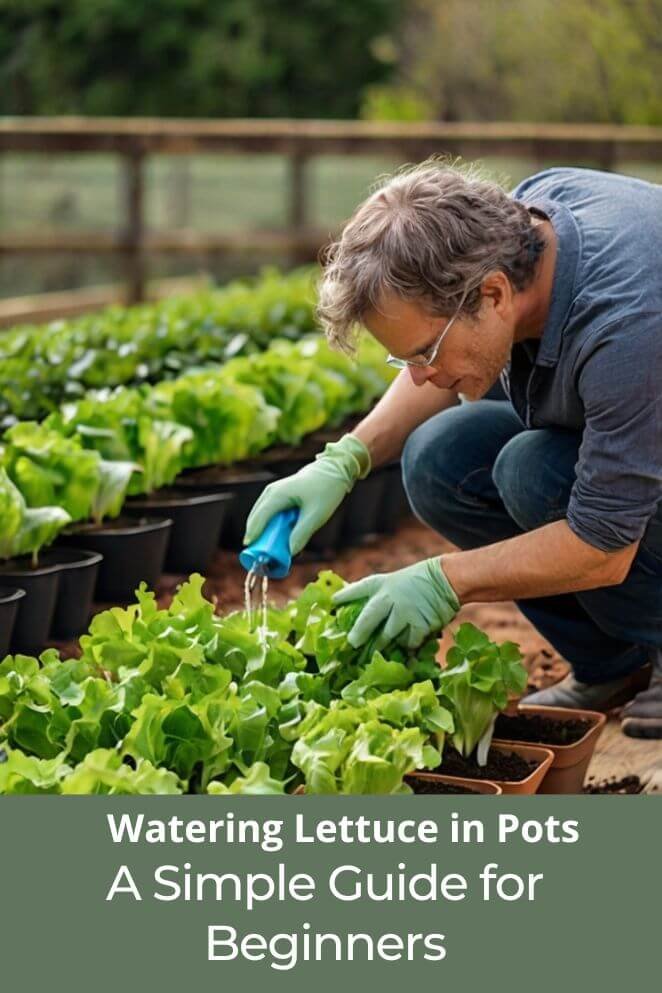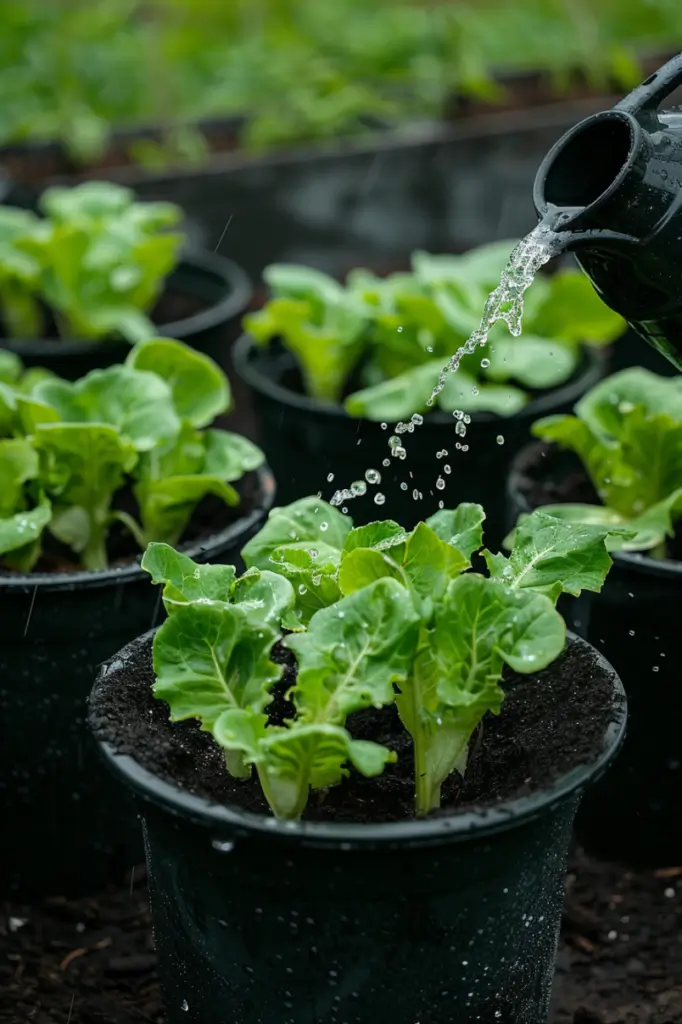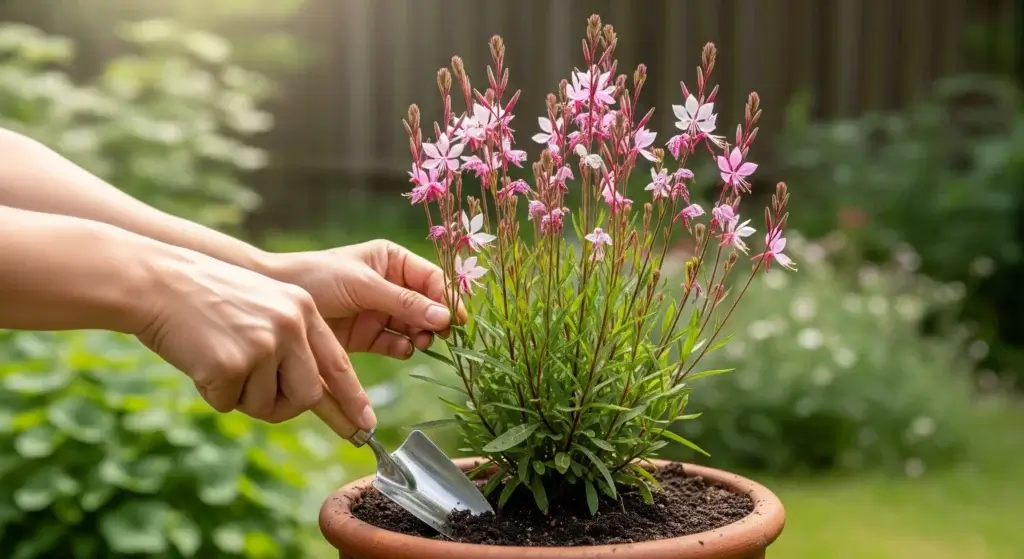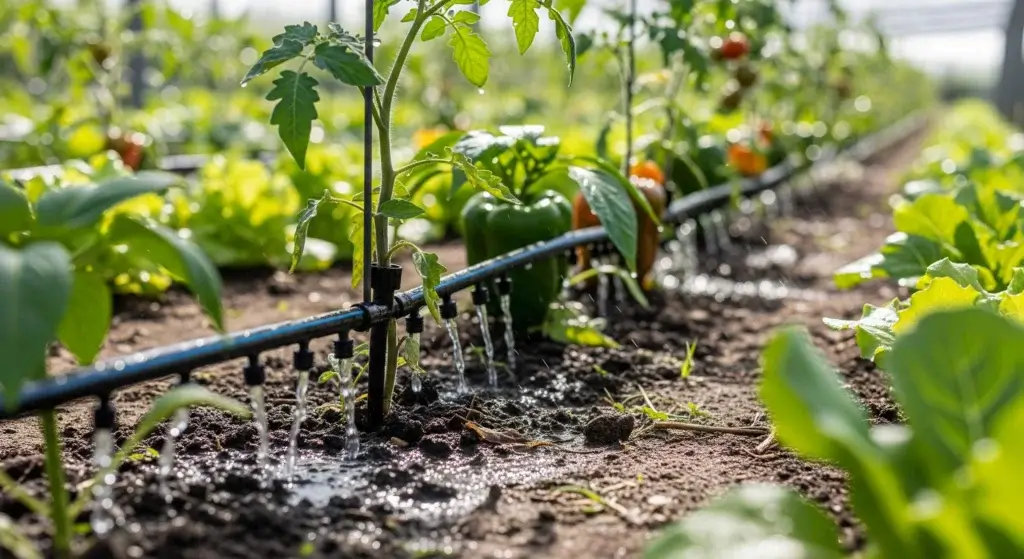
Growing lettuce in pots is a fantastic way to enjoy fresh, homegrown greens even if you lack garden space.
However, watering lettuce properly is crucial for healthy growth and a bountiful harvest.
This guide will walk you through understanding lettuce watering needs, the best watering techniques, common mistakes to avoid, and additional tips to ensure your lettuce thrives.
Understanding Lettuce Watering Needs
Lettuce is a cool-weather crop that requires consistent moisture to grow well.
Understanding its specific watering needs will help you keep your potted lettuce healthy and productive.
Lettuce water requirements
Lettuce needs regular watering, but the frequency and amount can vary depending on factors like pot size, soil type, and weather conditions.
Generally, lettuce prefers evenly moist soil, not waterlogged or bone dry.
- Frequency: Water lettuce 2-3 times a week, but adjust based on weather and soil conditions. In hotter weather, you may need to water more frequently.
- Amount: Provide enough water to moisten the soil to a depth of 6 inches. Avoid saturating the soil, as this can lead to root rot.
Soil moisture
Monitoring soil moisture levels is key to ensuring your lettuce gets the right amount of water.
Here’s how you can check for optimal moisture levels:
- Finger test: Insert your finger about 1-2 inches into the soil. If it feels dry at this depth, it’s time – to water.
- Moisture meter: Use a moisture meter to get an accurate reading of the soil’s moisture level. Aim for a reading that indicates the soil is consistently moist.

- Read also: Nurturing Greenery: A DIY Potted Plant Watering System Guide
- Read also: Tips and Tricks: A Guide to Watering Your Cauliflower Plants
Watering Techniques for Lettuce in Pots
Choosing the right watering technique can make a big difference in the health of your lettuce.
Here are some effective methods:
Watering frequency
The ideal frequency and timing for watering lettuce in pots depend on several factors, including the size of the pot, type of soil, and weather conditions.
A general guideline is to water your lettuce every 2-3 days, ensuring the soil remains consistently moist but not waterlogged.
Watering methods
Watering from the bottom
Watering from the bottom involves placing the pot in a tray filled with water, allowing the soil to absorb moisture through the drainage holes.
This method is beneficial because it encourages deep root growth and reduces the risk of fungal diseases on the leaves.
Steps
- Fill a tray with water.
- Place the pot in the tray for about 30 minutes.
- Remove the pot and let excess water drain.
Watering from the top
Watering from the top is straightforward and ensures that water reaches the roots quickly.
However, it can also promote fungal diseases if water consistently splashes onto the leaves.
Steps
- Use a watering can with a fine rose to gently water the soil surface.
- Aim to water the soil directly and avoid wetting the leaves.
- Water until it begins to drain from the bottom of the pot.
Misting
Misting the leaves can help maintain humidity and prevent the lettuce from drying out, especially in hot or dry conditions.
However, it should not replace regular watering.
Steps
- Use a spray bottle to mist the leaves lightly.
- Mist in the morning to allow leaves to dry during the day, reducing the risk of fungal diseases.
Water quality
The quality of water used for watering lettuce is important. Chlorinated tap water can be harmful, so it’s best to use filtered or rainwater if possible.
Tips
- Let tap water sit for 24 hours to allow chlorine to dissipate.
- Use a water filter to remove impurities.
- Collect rainwater for a natural and cost-effective option.

Common Mistakes to Avoid
Avoiding common watering mistakes can make a significant difference in the health of your potted lettuce.
Overwatering
Signs
Wilting leaves, yellowing of leaves, and mold growth on the soil surface are signs of overwatering.
These indicate that the roots are suffocating due to excessive moisture, which can lead to root rot and other fungal issues.
Solution
Allow the soil to dry out slightly between waterings.
Use pots with good drainage holes to prevent water from pooling at the bottom.
Adjust your watering schedule based on environmental conditions, such as humidity levels and seasonal changes.
Underwatering
Signs
Lettuce plants will show signs of stress if they aren’t getting enough water.
This includes wilted, dry leaves and slowed growth.
Underwatering can stunt the plant’s development and reduce crop yield.
Solution
Check the moisture level of the soil regularly by inserting your finger into the soil up to the first knuckle.
If it feels dry, it’s time to water.
Consistent watering ensures that lettuce plants receive the moisture they need to thrive.
Watering at the wrong time
Best time
The optimal times to water potted lettuce are early in the morning or late in the evening when temperatures are cooler.
This allows the water to soak into the soil without evaporating too quickly in the heat.
Worst time
Avoid watering during the hottest part of the day, as water can evaporate rapidly from the soil surface.
This can stress the plants and reduce the effectiveness of watering efforts.
Additional tips
Consider using mulch on the soil surface to retain moisture and reduce evaporation.
This helps maintain a more consistent soil moisture level throughout the day.

Additional Tips and Tricks
Here are some extra tips to help you get the most out of your potted lettuce:
Mulching
- Purpose: Mulching helps retain moisture in the soil and suppresses weeds, which can compete with lettuce for nutrients.
- Types of mulch: Use organic materials such as straw, grass clippings, or compost. These materials break down over time, enriching the soil with nutrients.
- Application: Apply a thin layer of mulch around the base of the lettuce plants, ensuring it doesn’t touch the stems. This layer helps keep the soil cool and moist, creating a favorable environment for lettuce growth.
Monitoring temperature
Lettuce preferences
Lettuce thrives in cooler temperatures and can bolt (go to seed) prematurely in high heat.
Tips
- During hot weather, move potted lettuce to a shaded area where it receives indirect sunlight. This helps prevent the plants from overheating and bolting.
- Use shade cloth or other light covers to shield lettuce plants from direct sunlight during the hottest parts of the day. This reduces stress on the plants and maintains optimal growing conditions.
Pruning
Purpose
Pruning or harvesting lettuce helps promote healthy growth by encouraging new leaf development and preventing overcrowding.
Steps
- Regularly harvest outer leaves of the lettuce plants as they mature. This encourages the plant to produce more leaves and prevents it from becoming overcrowded.
- Remove any yellowing or damaged leaves promptly. This improves air circulation around the plant and reduces the risk of fungal diseases.

- Read also: Thirsty for Success: Tips on Watering Cabbage Plants
- Read also: Don’t Drown It! The Perfect Watering Requirements For Broccoli
Conclusion
Watering lettuce in pots requires attention to detail and a good understanding of the plant’s needs.
By following the guidelines and techniques outlined in this post, you can ensure your lettuce thrives and provides you with a bountiful harvest.
Remember to monitor soil moisture, use proper watering methods, and avoid common mistakes to keep your lettuce healthy and productive.
FAQs
Water lettuce every 2-3 days, but adjust based on soil moisture and weather conditions.
Early morning or late evening is the best time to water lettuce to prevent evaporation and reduce plant stress.
Yes, but it’s best to let tap water sit for 24 hours to allow chlorine to dissipate or use filtered or rainwater.
Check soil moisture regularly and ensure good drainage. Allow the soil to dry slightly between waterings.



